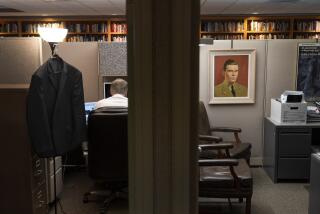Deaver’s Involvement on Acid Rain Told
- Share via
WASHINGTON — Former National Security Adviser Robert C. McFarlane and two other former officials of the Reagan Administration testified Monday that Michael K. Deaver was involved in high-level talks on the Canadian acid rain problem--despite his sworn testimony that he could not recall such discussions.
The statements by McFarlane, former U.S. Ambassador Paul H. Robinson Jr. and former National Security Council aide Robert Kimmitt marked the most damaging day of testimony against President Reagan’s former close aide and confidant as his perjury trial began its fourth week.
Independent counsel Whitney North Seymour Jr., who called the three witnesses, is trying to prove to a federal jury that Deaver lied to investigators about his involvement with Canadian acid rain to help protect a lucrative $105,000 lobbying contract he had signed with the Canadian government shortly after leaving the White House in May, 1985.
‘Personal Involvement’
Federal ethics laws prohibit a former high government official such as Deaver from representing a business client before former government colleagues for a year after leaving government service on an issue in which he had “substantial and personal involvement.”
McFarlane, who resigned from the White House in December, 1985, said Deaver met with Canadian emissary Fred Doucet on the acid rain problem Jan. 31, 1985, at the White House and minutes later brought Doucet to McFarlane’s office for a picture of all three men. The color photo was introduced as evidence.
McFarlane said that he and Deaver were among White House officials who were seeking to resolve the problem of rain-borne industrial pollution in early 1985 so that Reagan and Canadian Prime Minister Brian Mulroney could announce steps toward a mutual solution when they met on March 17 of that year.
Special Envoy
McFarlane, Robinson and Kimmitt told jurors that Reagan and Mulroney announced after the summit that each nation would appoint a special envoy to work on the joint problem. McFarlane and Kimmitt testified and identified documents indicating that Deaver took part in discussions leading to Reagan’s appointment of former Transportation Secretary Drew Lewis to that post.
Deaver swore to congressional investigators and to a federal grand jury last year that he could not recall any discussions about acid rain before March 6, 1985--11 days before the March 17 summit.
Robinson, who then was U.S. ambassador to Ottawa, testified that he and Deaver spoke with Canadian Ambassador Allan Gotlieb about acid rain as early as Dec. 17, 1984, while helping to plan for the summit. Robinson said that while he, Deaver and Gotlieb were riding to the Ottawa airport that day, Gotlieb “made a very strong pitch about there being some movement (by the United States) on acid rain.”
‘See What We Can Do’
“Mr. Deaver turned to me and said: ‘See what we can do about this and try not to bureaucratize it,” Robinson testified.
Kimmitt, meanwhile, identified documents showing that Deaver discussed the appointment of special envoys at least three times before March 6, the date Deaver said was “the first time that I heard of the concept of special envoy.”
McFarlane also told jurors that Deaver called him on May 24, 1985, concerning a Puerto Rican tax issue of interest to a brokerage house that Deaver was representing. This too contradicted sworn testimony by Deaver, who told grand jurors last year that he could not recall any such contact.
More to Read
Sign up for Essential California
The most important California stories and recommendations in your inbox every morning.
You may occasionally receive promotional content from the Los Angeles Times.













